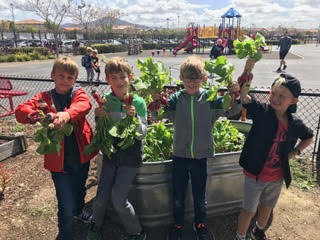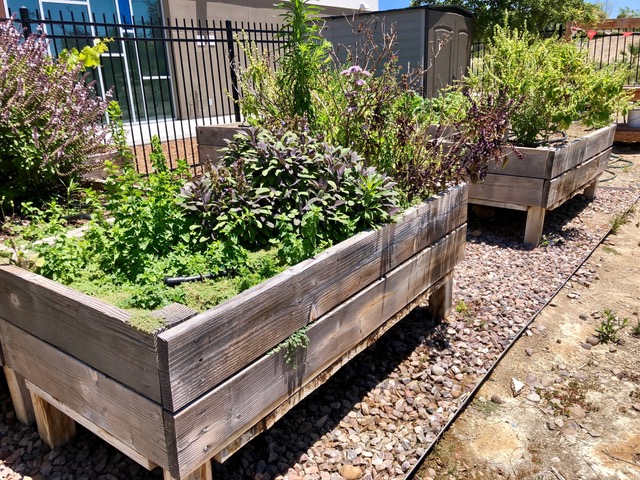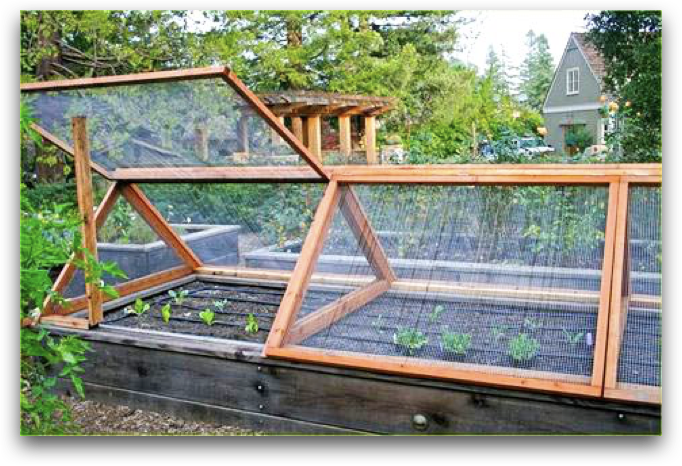Many pests, both vertebrates (rabbits, gophers, etc.), and invertebrates (aphids, ants, whiteflies, etc.) inhabit our gardens. Some of the critters that frequent our growing spaces are, in fact, beneficial (lady beetles and many spiders). Many of these inhabitants live in harmony with each other. Only a few cause problems for the rest of the garden community.
Integrated Pest Management
Integrated Pest Management (IPM) is a comprehensive program that focuses on long-term prevention of pests or their damage through a combination of techniques such as biological control, habitat manipulation, modification of cultural practices, and use of resistant varieties. IPM does not eliminate garden pests, but endeavors to keep pests under control and reduce their damage to a tolerable level by encouraging beneficial insects, trapping, using barriers, rotating crops, and mulching. With IPM, deciding to use a pesticide is the last option to consider for managing pests. IPM also encourages good irrigating, tilling, and pruning techniques and proper garden clean up. IPM is an important method of pest control in school gardens.
In the schoolyard where children are present, chemical pesticides usually cannot be used. Contact the school pest control department if there is an extremely serious problem, and chemical pesticides are necessary. They have trained personnel available or under contract who will inspect the problem and apply the correct product when children are not present. For many years, overuse of pesticides has resulted in:
-
- Insects becoming resistant to pesticides.
- Destroying beneficial organisms that attack pests.
- Misused chemical products causing environmental harm.
Some pest damage can often be tolerated in a school garden, and some pests can be controlled without chemicals. Washing plants with a forceful spray of water, hand picking and destroying the pests, encouraging beneficial insects, or using barriers can be effective pest controls. Least toxic pesticides commonly available include: insecticidal soap, horticultural oil, Neem spray and Bt (Bacillus thuringiensis). Any pesticide product used in the garden must list the crop plant to be treated and the pest being controlled. Pest problems, of course, will vary with region, climate, crop variety, soil type and general gardening practices.
Employing practices to deter pests and controlling pests when they first appear can help prevent the buildup of a large population later. Garden pests seek places to live that satisfy their basic needs for moisture, food and shelter. If you make an environment less favorable for a pest it may not thrive and may move elsewhere.
To make your garden less attractive to pests:
-
- Have the soil tested before planting to determine if you need to adjust the pH. Most plants grow best with a pH between 6.0 and 7.0.
- Make sure your garden’s soil drains well. Raised beds will improve drainage. Add organic material (compost) and other amendments to the soil, if needed, before planting.
- Select healthy plants, seedlings and seeds that are known to resist diseases and are well suited to the climate. Fertilize them well. Strong plants are more likely to survive attacks by pests.
- Grow different types of plants in adjacent rows. When possible select plants in different families. Pests that prefer one type of vegetable may not move to the next row if different vegetables are in the neighboring rows.
- Do not plant the same crop in the same place year after year. Rotate crops from different crop families.
- Mulch the garden with leaves, straw, shredded or chipped bark, or dry grass clippings to keep down weeds and conserve water. Maintaining a weed-free garden will help control certain pests and diseases.
- Employ beneficial organisms to help control pests. Protect natural populations of lady beetles and other beneficial organisms. Birds, ladybugs, spiders, green lacewings, dragonflies, centipedes, and praying mantis all eat aphids, mealybugs, whiteflies and mites.
- Use traps to control mice, rats, gophers and squirrels. Fencing the garden with poultry wire, buried 6 inches deep, is an effective method of keeping out rabbits.
- Compost garden waste and dead vegetation.
When you discover a pest or disease, there are three steps to effectively managing it.
Identify the Problem
The most important step of IPM is going out to the garden on a regular basis and systematically checking the plants for pests and symptoms of damage. Examine the plants at least once or twice a week during the growing season. Walk through the garden turning over leaves to check for signs of insects or disease. Use a notebook for keeping records, a ten-power magnifying lens for viewing small insects, and small plastic bags or jars for collecting samples to be identified later. Involving students in this activity helps develop their observation and insect identification skills.
When you discover a problem, the first step is to identify its nature. What is causing the problem? Is it an insect, a soil-borne pathogen, too much or too little water, sun scald, gophers, rabbits, snails or slugs, birds? Or, has a child stepped on the plants or pulled the plant apart?
Is the problem in one part of the garden, isolated on one type of plant (e.g., cabbages), or is it also on other plants in other parts of the garden? Do not treat the whole garden for a localized problem. Use a notebook to record what you learn. Have students go into the garden to make notes on problems they find.
Once the pest information is collected, have the students use several sources to research and identify the problem and learn effective methods to control it. Sources include library reference books, such as insect field guides or gardening books. Three excellent publications are:
-
-
-
- Pests of the Garden and Small Farm, A Grower’s Guide to Using Less Pesticide by The University of California, Division of Agriculture and Natural Resources, publication number 3332
- A Citizen’s Guide to Pest Control and Pesticide Safety by the United States Environmental Protection Agency, publication number EPA 730-K-95-001
- University of California Guide to Solving Garden and Landscape Problems on CD, publication number 4300
-
-
In San Diego County, you may email questions to help@mastergardenerssandiego.org, or call the University of California Cooperative Extension, Master Gardener Information Hot Line (858) 822-6910 for free advice on gardening problems. Local garden centers are also good sources for solutions to gardening problems. However, they may recommend chemicals they sell.
Choose an Appropriate Treatment Option
After you identify a problem, select the best solution to solve it.
Ask yourself these questions:
-
-
-
- Does the garden really need to be insect free? Can you tolerate some blemished plants or fruits in your garden?
- Are beneficial insects present in the garden?
- Can you replace the plants with hardier disease resistant varieties?
- Is there a way to restrict the pest’s access to the garden?
- Are you meeting the plants’ horticultural needs for water, nutrients etc.?
-
-
The best solution may be:
-
-
-
- Washing the plant with a strong water spray.
- Changing the watering schedule.
- Spraying the plant with insecticidal soap or a botanical pesticide such as Bacillus thuringiensis, commonly known as Bt. Check your school district policy on using insecticidal soap and Bt.
- Treating some plants and leaving others untreated for comparison.
- Doing nothing.
-
-
If you are still uncertain, research additional references or get advice from a gardening professional. Your Master Gardener School Garden Consultant can help you find answers to those you can not find on your own.
Evaluate the Results
After choosing and implementing your plan of attack, allow time for it to work and then evaluate its effectiveness. Compare pre-treatment and post-treatment conditions. Is there evidence of a reduction in the number of pests? Improvement in the disease symptoms?
You may choose from many different methods as you plan your strategy for controlling garden pests. Sometimes a non-chemical method is as effective and convenient as many chemical alternatives. For many pests, total elimination is almost impossible, but it is possible to control them.
NOTE: The University of California website has detailed information on many pests including the common ones we cover here. You will be able to learn how to identify the pest, its life cycle, the damage it causes and the best management techniques. For many pests, there is also a printable Pest Note that summarizes the information. To access Pest Notes go to the UC IPM Pest Note Index.
Use Beneficial Insects to Control Pests
Natural enemies are organisms that kill, decrease the reproductive potential or otherwise reduce the numbers of another organism. Natural enemies that limit pests are key components of integrated pest management programs. Some of the natural enemies to encourage in your garden are the lady beetle, mealybug destroyer, and the syrphid fly. The UC IPM Natural Enemies Gallery provides more information on these and other Beneficial Insects.
Convergent Lady Beetle
Both adults and larvae of lady beetles feed primarily on aphids and occasionally on whiteflies, other soft-bodied insects, and insect eggs.
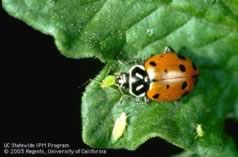

Mealybug Destroyer
The adult mealybug destroyer is small, measuring 3 to 4 mm (1/6 inch) long, and is mostly dark brown or blackish with an orange head and tail. Larvae grow up to 1.3 cm (1/2 inch) long and are covered with waxy white curls making it difficult to see their legs. Larvae resemble mealybugs except that they are larger and more active. Mealybug Destroyer eggs are yellow and are laid among the cottony egg sacks of mealybugs. Both adults and larvae feed on exposed mealybug species and other pests. They are most effective at controlling mealybugs when the mealybug population is high.

Syrphid Flies
Syrphid flies are regularly found where aphids are present in agricultural, landscape, and garden habitats. Adults of this stingless fly hover around flowers, have black and yellow bands on their abdomen, and are often confused with honeybees.
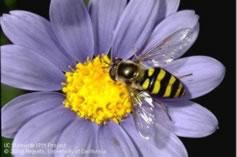
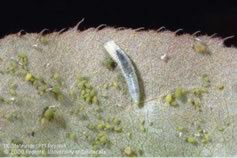
Invertebrate Pests
Garden pests are generally divided into vertebrates, those with a backbone, and invertebrates, those lacking a backbone. Invertebrates that damage plants include mollusks (snails and slugs), nemotode worms, mites, and insects including aphids, psyllids, whiteflies, mealy bugs, cabbage loopers, cutworms, earwigs, grasshoppers, and tomato hornworms. Ants are not only a nuisance for the gardeners, but also protect honeydew excreting insects, such as aphids, from their natural predators.
Ants
When numerous ants are found on plants, they are probably attracted to the sweet honeydew deposited on the plants by honeydew-producing insects such as aphids, mealy bugs or soft scales. Frequently outbreaks of scales and aphids occur when ants tend them for honeydew, because the ants protect scales and aphids from their natural enemies.
Some ants will climb trees or shrubs to feed on floral nectar and over-ripe or rotting fruit. A sticky substance, such as Tanglefoot®, will block ants from climbing the trunk. Wrap a protective collar of heavy plastic around the trunk. Apply a thin coating of the sticky material to the wrap. Applying Tanglefoot® directly to the bark may damage the plant. Trim branches to keep them from touching structures or other plants so ants are forced to climb the trunk to reach the foliage. For more information go to the UC Pest Note on Ants.
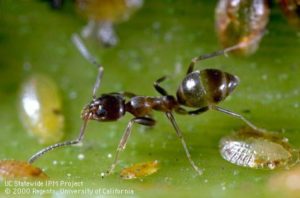
Aphids
Aphids are small, soft-bodied insects with long, slender mouth parts that they use to pierce stems, leaves, and other tender plant parts to suck out plant fluids. They come in a variety of colors (rose, black, green, and yellow, among others). Almost every plant has one or more aphid species that occasionally feeds on it. Large populations cause curling, yellowing, and distortion of leaves and stunting shoots. Aphids feed on plant sap and secrete large quantities of sticky liquid called honeydew. The sticky residue on leaves often turns black with the growth of a benign sooty mold fungus. For more information go to the UC Pest note on Aphids.
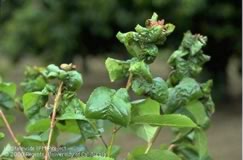
Spider Mites
Spider mites are the most common mite pest in the garden. To the naked eye, spider mites look like tiny moving dots. However, you can see them easily with a 10 x hand lens. Adult females, the largest forms, are less than 1/20 inch long. Spider mites live in colonies, mostly on the under-surfaces of leaves. A single colony may contain hundreds of mites. The names “spider mite” and “webspinning mite” come from the fine silk webbing that they produce on infested leaves. The presence of webbing is an easy way to distinguish them from all other types of mites. Spider mites pierce plant cells to feed on sap that discolors and dries plant tissues. For more information go to the UC Pest Note on Spider Mites.
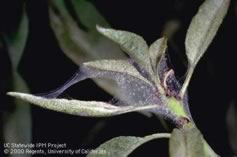
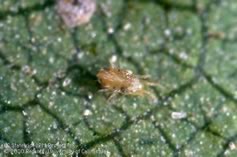
Mealybugs
Mealybugs are soft, oval, flat, distinctly segmented, and covered with a white mealy wax that extends into spines (filaments) along the body margin and the posterior end. The species differ mainly in the thickness and length of the waxy filaments. There are many species. The most common is the Citrus mealybug which has a pinkish body that is visible through the powdery wax. Mealybugs extract plant sap, which weakens plants, and excrete honeydew. If a cluster of mealybugs feeds along a fruit stem of citrus, fruit drop can occur. Damage is most severe in spring and fall. For more information go to the UC Pest Note on Mealy Bugs.
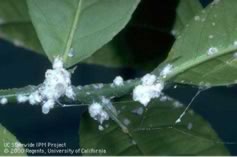
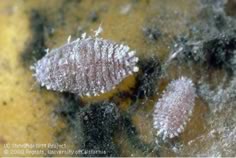
Whiteflies
Whiteflies are tiny, sap-sucking insects that are frequently abundant in vegetable and ornamental plantings. They excrete sticky honeydew and cause yellowing or dying leaves. Whiteflies usually occur in groups on the undersides of leaves. When lady beetles and other natural enemies do not adequately control white flies, they can develop large populations and damage plants. They derive their name from the mealy, white wax covering the adult’s wings and body. Adults are tiny insects with yellowish bodies and whitish wings. For more information go to the UC Pest Note on Whiteflies.
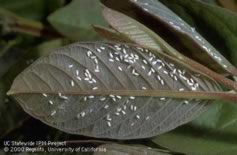
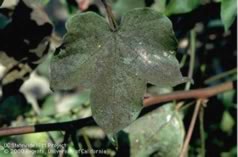
Citrus Leafminer larvae feed by creating shallow tunnels, referred to as mines, in young leaves. It is most commonly found on citrus (e.g., oranges, mandarins, lemons, limes, grapefruit) and closely related trees (kumquat and calamondin). The larvae mine the lower or upper surface of the leaves causing them to curl and look distorted. Mature citrus trees (more than 4 years old) generally tolerate leaf damage without any effect on tree growth or fruit yield. Citrus leafminer is likely to cause damage in nurseries and new plantings because the growth of young trees is retarded by leafminer infestations. However, even when infestations of citrus leafminer are heavy on young trees, trees are unlikely to die. For more information go to the UC Pest Note on Citrus Leaf Miner.
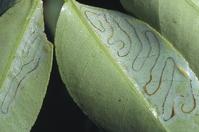
Asian Citrus Psyllid
The Asian Citrus Psyllid is a tiny, mottled brown insect about the size of an aphid. It damages citrus directly by feeding on new foliage as tiny leaves begin to grow. The psyllid feeds on all varieties of citrus. It also kills trees indirectly. The insect is a vector of the bacterium that causes the fatal citrus disease Huanglongbing (HLB), also called Citrus Greening Disease.
This disease is the most serious threat to citrus trees worldwide – including those grown in home gardens and on farms. The psyllid takes the bacteria into its body when it feeds on bacteria – infected plants. The disease spreads when an infected psyllid injects bacteria into the plant as it feeds. For more information go to the UC Pest Note on Asian Citrus Psyllid.
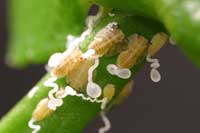
Tomato Hornworm
This hornworm feeds on tomato blossoms, leaves and fruit. If the population is high, they can extensively defoliate plants and scar the fruit. Hornworms are well camouflaged and difficult to see on the plants. The first indication of their presence may be seeing the droppings. For more information go to the UC Pest Note on Hornworms.
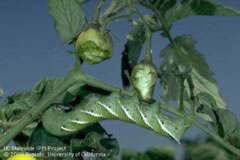
Snails and Slugs
Snails and slugs are Mollusks and are among the most bothersome pests in many garden and landscape situations. They chew irregular holes with smooth edges in leaves and flowers and can clip succulent plant parts. They can also chew fruit and young plant bark. Because they prefer tender foliage or flowers, they are primarily pests of seedlings and herbaceous plants, but they are also serious pests of ripening fruits, such as strawberries, artichokes, and tomatoes, that are close to the ground. Snails and slugs feed mainly at night but may also be active during the day in rainy or cloudy weather. As they travel, they excrete slime and leave a dry, silvery trail that is a clue to their presence. For more information go to the UC Pest Note on Snails and Slugs.
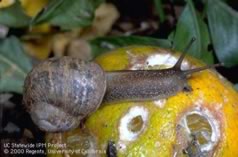
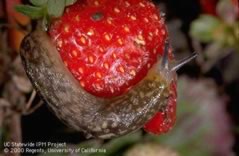
Root Knot Nematodes
These microscopic roundworms live in the soil and feed on roots of most crops. Control measures include solarizing the soil with clear plastic, rotating crops, and planting resistant varieties, if available. The letter “N” indicates a hybrid tomato variety is resistant to nematodes (e.g., Better Boy VFN). for more information go to the UC Pest Note on Nematodes.
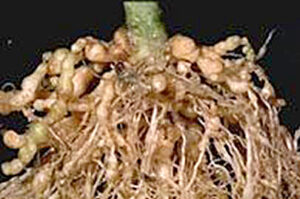
Vertebrate Pests
Some of the most common vertebrate pests are Rabbits, California Ground Squirrels, Pocket Gophers, Roof Rats, and Voles (Meadow Mice).
California Ground Squirrel
The California ground squirrel is one of the most troublesome pests to homeowners and gardeners. Ground squirrels damage many vegetables, fruit and ornamental plants. They prefer seeds and fruit most of the year but also feed on foliage in spring and frequently damage vegetables and flowers. Grains and fruit and nut trees are particularly vulnerable. For more information go to the UC Pest Note on Ground Squirrels.
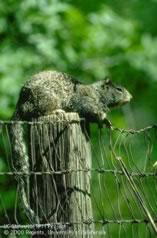
Pocket Gopher
Pocket gophers are burrowing rodents that get their name from the fur-lined external cheek pouches, or pockets, that they use for carrying food and nesting materials. They often invade yards and gardens and feed on many garden crops, ornamental plants, vines, shrubs, and trees. A single gopher moving down a garden row can inflict considerable damage in a very short time. Gophers also gnaw and damage plastic water lines and lawn sprinkler systems. For more information go the UC Pest Note on Pocket Gophers.
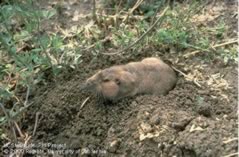
Rabbits
Rabbits can be very destructive in gardens and landscapes – especially where wild or uncultivated lands border residential zones, parks, greenbelts, or other landscaped places. Rabbits are active from dusk to dawn. Open lands such as uncultivated, wild areas provide resting and hiding cover during the day within easy travel distances to prime, irrigated food sources. Rabbit damage is frequently found on vegetables, tree and berry crops, herbs and ornamental plants.
Rabbits also gnaw and cut plastic irrigation lines, especially small diameter tubes. You can protect them by hanging them out of the reach of rabbits or by encasing them in regular 3/4-inch PVC pipe. For more information go to the UC Pest Note on Rabbits.
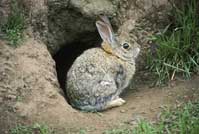
Roof Rat
Roof Rats are some of the most troublesome and damaging rodents in the United States. They consume and contaminate food, damage structures and property, and transmit parasites and diseases to other animals and humans. They also damage garden crops and ornamental plantings. They forage for food at night and hide during the day. They are very agile and will climb trees to feed on fruits and nuts. For more information go to the UC Pest Note on Rats.
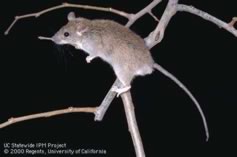
Voles (Meadow Mice)
Voles do not commonly invade homes, and should not be confused with the house mouse. Voles live outdoors and cause damage by feeding on a wide range of garden plants including artichoke, beet, Brussels sprouts, cabbage, carrot, cauliflower, celery, lettuce, turnip, sweet potato, spinach, and tomato. They may also damage turf and other landscape plantings such as lilies and dichondra. Voles will gnaw the bark of fruit trees including almond, apple, avocado, cherry, citrus, and olive. For more information go to the UC Pest Note on Voles.

Excluding Vertebrate Pests
Exclusion is the best method for protecting your garden from vertebrate pests. If you have raised beds, screening the bottom with hardware cloth will keep gophers at bay. If you do not have raised beds, bury hardware cloth or ½ to ¾ inch mesh poultry wire at least 2 feet deep to deny them access to your garden. To keep gophers from digging under the fence, when possible, have an additional 6 inches of hardware cloth at the bottom bent at a 90° angle away from the planting area. Also, extend the fencing at least one foot above ground to deter gophers from travelling above ground.
Fences will help protect your plants from voles and rabbits. To keep voles out, surround the garden area with a one foot high fence made of galvanized ¼ inch mesh hardware cloth and bury it 6 to 10 inches in the ground. Rabbits require a 4 foot high fence made of 1 inch or smaller mesh chicken wire or hardware cloth. It also needs to extend 10 inches underground. Options to deter squirrels and gophers include using raised beds on legs, flashing around the sides of the beds, or with an overhang or seat at the top. You can also completely cover the beds with poultry wire or plastic or row cover fabric supported on a frame of wood or PVC pipe. Galvanized horse troughs are another solution for excluding squirrels and gophers.
